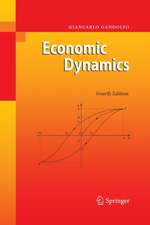New Approaches in Classification and Data Analysis: Studies in Classification, Data Analysis, and Knowledge Organization
Editat de Edwin Diday, Yves Lechevallier, Martin Schader, Patrice Bertrand, Bernard Burtschyen Limba Engleză Paperback – 10 noi 1994
Din seria Studies in Classification, Data Analysis, and Knowledge Organization
- 20%
 Preț: 754.10 lei
Preț: 754.10 lei - 20%
 Preț: 1203.32 lei
Preț: 1203.32 lei -
 Preț: 389.49 lei
Preț: 389.49 lei - 20%
 Preț: 587.30 lei
Preț: 587.30 lei - 18%
 Preț: 886.26 lei
Preț: 886.26 lei - 18%
 Preț: 968.30 lei
Preț: 968.30 lei - 18%
 Preț: 1017.26 lei
Preț: 1017.26 lei -
 Preț: 417.41 lei
Preț: 417.41 lei - 18%
 Preț: 1113.09 lei
Preț: 1113.09 lei - 15%
 Preț: 645.14 lei
Preț: 645.14 lei - 15%
 Preț: 660.04 lei
Preț: 660.04 lei - 20%
 Preț: 583.38 lei
Preț: 583.38 lei - 15%
 Preț: 637.59 lei
Preț: 637.59 lei -
 Preț: 406.05 lei
Preț: 406.05 lei - 20%
 Preț: 997.38 lei
Preț: 997.38 lei - 18%
 Preț: 958.07 lei
Preț: 958.07 lei - 18%
 Preț: 949.06 lei
Preț: 949.06 lei - 18%
 Preț: 784.13 lei
Preț: 784.13 lei - 20%
 Preț: 999.53 lei
Preț: 999.53 lei - 18%
 Preț: 1391.52 lei
Preț: 1391.52 lei - 15%
 Preț: 657.25 lei
Preț: 657.25 lei - 18%
 Preț: 964.10 lei
Preț: 964.10 lei - 18%
 Preț: 962.35 lei
Preț: 962.35 lei - 15%
 Preț: 649.71 lei
Preț: 649.71 lei - 20%
 Preț: 1013.06 lei
Preț: 1013.06 lei - 15%
 Preț: 652.81 lei
Preț: 652.81 lei - 15%
 Preț: 647.73 lei
Preț: 647.73 lei - 20%
 Preț: 585.30 lei
Preț: 585.30 lei - 24%
 Preț: 795.80 lei
Preț: 795.80 lei - 20%
 Preț: 1464.66 lei
Preț: 1464.66 lei - 20%
 Preț: 559.44 lei
Preț: 559.44 lei - 15%
 Preț: 647.59 lei
Preț: 647.59 lei - 15%
 Preț: 650.04 lei
Preț: 650.04 lei - 15%
 Preț: 647.73 lei
Preț: 647.73 lei -
 Preț: 398.15 lei
Preț: 398.15 lei - 20%
 Preț: 572.09 lei
Preț: 572.09 lei - 15%
 Preț: 639.59 lei
Preț: 639.59 lei - 15%
 Preț: 683.40 lei
Preț: 683.40 lei - 15%
 Preț: 695.01 lei
Preț: 695.01 lei -
 Preț: 423.34 lei
Preț: 423.34 lei - 18%
 Preț: 945.30 lei
Preț: 945.30 lei - 15%
 Preț: 652.64 lei
Preț: 652.64 lei -
 Preț: 391.40 lei
Preț: 391.40 lei - 20%
 Preț: 561.12 lei
Preț: 561.12 lei - 20%
 Preț: 1002.67 lei
Preț: 1002.67 lei - 15%
 Preț: 640.37 lei
Preț: 640.37 lei - 20%
 Preț: 996.88 lei
Preț: 996.88 lei - 20%
 Preț: 1007.46 lei
Preț: 1007.46 lei - 15%
 Preț: 646.11 lei
Preț: 646.11 lei
Preț: 654.43 lei
Preț vechi: 769.92 lei
-15% Nou
Puncte Express: 982
Preț estimativ în valută:
125.24€ • 135.99$ • 105.20£
125.24€ • 135.99$ • 105.20£
Carte tipărită la comandă
Livrare economică 22 aprilie-06 mai
Preluare comenzi: 021 569.72.76
Specificații
ISBN-13: 9783540584254
ISBN-10: 3540584250
Pagini: 708
Ilustrații: XII, 693 p.
Dimensiuni: 140 x 216 x 37 mm
Greutate: 0.81 kg
Editura: Springer Berlin, Heidelberg
Colecția Springer
Seria Studies in Classification, Data Analysis, and Knowledge Organization
Locul publicării:Berlin, Heidelberg, Germany
ISBN-10: 3540584250
Pagini: 708
Ilustrații: XII, 693 p.
Dimensiuni: 140 x 216 x 37 mm
Greutate: 0.81 kg
Editura: Springer Berlin, Heidelberg
Colecția Springer
Seria Studies in Classification, Data Analysis, and Knowledge Organization
Locul publicării:Berlin, Heidelberg, Germany
Public țintă
ResearchCuprins
Classification and Clustering: Problems for the Future.- From classifications to cognitive categorization: the example of the road lexicon.- A review of graphical methods in Japan—from histogram to dynamic display.- New Data and New Tools: A Hypermedia Environment for Navigating Statistical Knowledge in Data Science.- On the logical necessity and priority of a monothetic conception of class, and on the consequent inadequacy of polythetic accounts of category and categorization.- Research and Applications of Quantification Methods in East Asian Countries.- Algorithms for a geometrical P.C.A. with the L1-norm.- Comparison of hierarchical classifications.- On quadripolar Robinson dissimilarity matrices.- An Ordered Set Approach to Neutral Consensus Functions.- From Apresjan Hierarchies and Bandelt-Dress Weak hierarchies to Quasi-hierarchies.- Spanning trees and average linkage clustering.- Adjustments of tree metrics based on minimum spanning trees.- The complexity of the median procedure for binary trees.- A multivariate analysis of a series of variety trials with special reference to classification of varieties.- Quality control of mixture. Application: The grass.- Mixture Analysis with Noisy Data.- Locally optimal tests on spatial clustering.- Choosing the Number of Clusters, Subset Selection of Variables, and Outlier Detection in the Standard Mixture-Model Cluster Analysis.- An examination of procedures for determining the number of clusters in a data set.- The gap test: an optimal method for determining the number of natural classes in cluster analysis.- Mode detection and valley seeking by binary morphological analysis of connectivity for pattern classification.- Interactive Class Classification Using Types.- K-means clustering in a low-dimensional Euclideanspace.- Complexity relaxation of dynamic programming for cluster analysis.- Partitioning Problems in Cluster Analysis: A Review of Mathematical Programming Approaches.- Clusters and factors: neural algorithms for a novel representation of huge and highly multidimensional data sets.- Graphs and structural similarities.- A generalisation of the diameter criterion for clustering.- Percolation and multimodal data structuring.- Classification and Discrimination Techniques Applied to the Early Detection of Business Failure.- Recursive Partition and Symbolic Data Analysis.- Interpretation Tools For Generalized Discriminant Analysis.- Inference about rejected cases in discriminant analysis.- Structure Learning of Bayesian Networks by Genetic Algorithms.- On the representation of observational data used for classification and identification of natural objects.- Alternative strategies and CATANOVA testing in two-stage binary segmentation.- Alignment, Comparison and Consensus of Molecular Sequences.- An Empirical Evaluation of Consensus Rules for Molecular Sequences.- A Probabilistic Approach To Identifying Consensus In Molecular Sequences.- Applications of Distance Geometry to Molecular Conformation.- Classification of aligned biological sequences.- Use of Pyramids in Symbolic Data Analysis.- Proximity Coefficients between Boolean symbolic objects.- Conceptual Clustering in Structured Domains: A Theory Guided Approach.- Automatic Aid to Symbolic Cluster Interpretation.- Symbolic Clustering Algorithms using Similarity and Dissimilarity Measures.- Feature Selection for Symbolic Data Classification.- Towards extraction method of knowledge founded by symbolic objects.- One Method of Classification based on an Analysis of the Structural Relationship between Independent Variables.- The Integration of Neural Networks with Symbolic Knowledge Processing.- Ordering of Fuzzy k-Partitions.- On the Extension of Probability Theory and Statistics to the Handling of Fuzzy Data.- Fuzzy Regression.- Clustering and Aggregation of Fuzzy Preference Data: Agreement vs. Information.- Rough Classification with Valued Closeness Relation.- Representing proximities by network models.- An Eigenvector Algorithm to Fit lp-Distance Matrices.- A non linear approach to Non Symmetrical Data Analysis.- An Algorithmic Approach to Bilinear Models for Two-Way Contingency Tables.- New Approaches Based on Rankings in Sensory Evaluation.- Estimating failure times distributions from censored systems arranged in series.- Calibration Used as a Nonresponse Adjustment.- Least Squares Smoothers and Additive Decomposition.- High Dimensional Representations and Information Retrieval.- Experiments of Textual Data Analysis at Electricité de France.- Conception of a Data Supervisor in the Prospect of Piloting Management Quality of Service and Marketing.- Discriminant Analysis Using Textual Data.- Recent Developments in Case Based Reasoning: Improvements of Similarity Measures.- Contiguity in discriminant factorial analysis for image clustering.- Exploratory and Confirmatory Discrete Multivariate Analysis in a Probabilistic Approach for Studying the Regional Distribution of Aids in Angola.- Factor Analysis of Medical Image Sequences (FAMIS): Fundamental principles and applications.- Multifractal Segmentation of Medical Images.- The Human Organism—a Place to Thrive for the Immuno-Deficiency Virus.- Comparability and usefulness of newer and classical data analysis techniques. Application in medical domain classification.- The Classification of IRAS Point Sources.- Astronomical classification ofthe Hipparcos input catalogue.- Group identification and individual assignation of stars from kinematical and luminosity parameters.- Specific numerical and symbolic analysis of chronological series in view to classification of long period variable stars.- Author and Subject Index.










